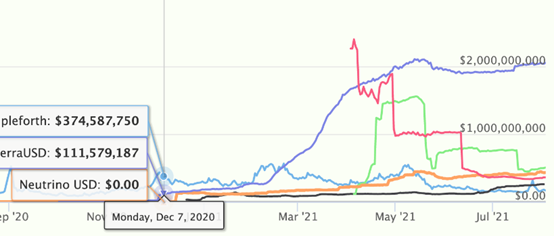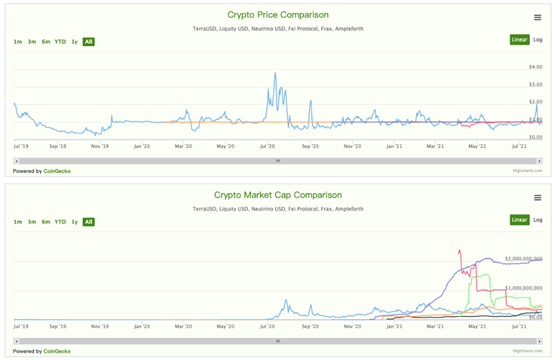Latest news about Bitcoin and all cryptocurrencies. Your daily crypto news habit.
What is the role of Stablecoins in DeFi? Which is the most successful stablecoin in DeFi? It is necessary for us to understand the current state of stable coins and opportunities in future, thus preparing forward-looking strategic reserves for the changing crypto market. We share our analysis according to the following outline:
1.The contribution of stablecoins to DeFi
2. List successful stablecoins according to data indicators and first principles
3. Regulator keep restraining DeFi and stablecoins, uncertainty increasing
4. Traditional over-collateralized stablecoins have inherent flaws and cannot exist for a long time. The algorithmic stablecoin model can solve them
5. Regardless of collateral type or algorithm type, the core reserve is the first element
6. For the initial issuance of stablecoins and subsequent issuance expansion, the reserve issuance model is better than the flexible issuance
7. Correctly distinguish (close) 1:1 transaction minting and over-collateralization minting are essentially different
8. At the level of pegging exchange rate, having an immediate arbitrage payment mechanism is better than long-term futures (that is, efficient open market operations are better than the bond model full of uncertainty)What is the role of Stablecoins in DeFi? Which is the most successful stablecoin in DeFi? It is necessary for us to understand the current state of stable coins and opportunities in future, thus preparing forward-looking strategic reserves for the changing crypto market. We share our analysis according to the following outline:
Stablecoins and DeFi

We have calculated the proportion of the three major stablecoins in the major protocols in the current total lock-up volume of DeFi ($ 70 billion).
• A total of $95.1 billion worth three major stablecoins is in circulation, of which about 20% ($18.5 billion) are stably locked in the DeFi ecosystem;
• USDC + DAI has a total of $33 billion in circulation, of which about 48% ($16 billion) are stably locked in the DeFi ecosystem, which is also the reason why Aave, InstaDapp, Compound, and Curve ushered in a surge in TVL after 519 market dump;
- USDC’s recent growth rate is extremely high. Nearly half of the increase flow to the DeFi protocol, and Dai obviously lost its growth rate after DeFi overheated, and most of its circulation is in DeFi.
USDT exists more in the trading game of centralized exchanges, so we want to talk about the contribution of USDC and DAI to the DeFi ecosystem, whether it is the previous crazy expansion period or the recent cold period. The scale of DAI ushered in the historical maximum (over $5 billion), carrying a large number of transaction and borrowing needs in the DeFi ecosystem, and USDC relies DeFi to achieve curve overtaking and completed a large-scale network against USDT. Especially recently, under the stimulus and assistance of the large regulatory environment and the real financial world in the West world, a huge amount of U.S. dollars has become USDC and injected into the DeFi ecosystem to obtain more considerable financial benefits. The financial systems of the two worlds have achieved efficient grafting because of a stablecoins. Therefore, we believe that it is unimaginable that stablecoins will give DeFi and DeFi will also give stablecoins in the future.
This brings hope to the future expansion of DeFi and other decentralized stablecoins led by DAI. To a certain extent, the slowdown in the growth rate of DAI also reflects the shortcomings of the existing mainstream decentralized stablecoin issuance, and it also puts forward the demand for other stablecoin projects and opens up options.
It is necessary to talk about the impact of regulation on stablecoins. The recent series of regulatory statements indicate that stablecoin supervision is on the agenda, especially directly pegged to the US dollar system. I believe that no stablecoin can be unaffected.
• Centralized stablecoins are required to disclose the reserve system (USDC, Paxos, etc.)
• Stablecoins are listed in VA supervision by FATF
• The SEC stated that the focus of legislation is on trading, lending and DeFi, and believes that stablecoins may also be securities and investment companies
This series of intensive statements will make the current stablecoin field more diversified, especially for decentralized stablecoins, it is difficult for the DAI family to cope with changes. A more compliant mechanism and richer choices will promote this field again. For example, some people believe that “in recent months, various countries and regions have gradually tightened the supervision of stablecoins. during the period may be an excellent time for the development of purely algorithmic and highly decentralized stablecoins. demonstrating the advantages of algorithmic stablecoins under unstable market conditions, including the de-foundation of MakerDAO.
In short, the long-term existence of the DeFi ecosystem will definitely generate long-term demand for diversified stablecoins. the two financial worlds can achieve unlimited possibilities in the future by using stablecoins as a graft. These further make supervision more urgent, and ultimately it must also be diversified and stable. The pattern of mutual development and mutual achievement of stablecoins has emerged.
Five successful stablecoins

The red flag represents the first-tier stablecoins. The collateral camp is led by MakerDAO, and the algorithm camp is led by Terra (UST); the yellow flag represents the second-tier stablecoins, represented by Frax, which has been growing rapidly recently, basically, they are all algorithm camps; the blue flag projects are in pending, but their own mechanisms still have a certain meaning after being baptized, and they also give them more expectations in the future. In addition to these stablecoins, we have given more time to verify the popular projects such as Celo/RAI/OHM, so they cannot be included for the time being. We have two criteria for judging these stablecoins:
- Long-term and continuous verification of market scales and excellent data performance-Lindy effect
- Its core mechanism can withstand more deterministic judgments at the logical level-First principle
Note: The Lindy effect (also known as Lindy’s Law) is a theorized phenomenon by which the future life expectancy of some non-perishable things, like a technology or an idea, is proportional to their current age. Thus, the Lindy effect proposes the longer a period something has survived to exist or be used in the present, it is also likely to have a longer remaining life expectancy.
Most of the seven projects listed have a life cycle of more than half a year. The special one such as Liquity, although the life cycle is short, but because the mechanism adopted is very similar to MakerDAO, it draws on the successful practice of MakerDAO and the core mechanism of collateralized stablecoins. The advantages (robustness and certainty) of the above, contribute their success. Apart from MakerDAO, we made a comparison of the other six projects (above). In the overall situation,
- Terra/UST (purple line) has a strong growth rate during the rising period of the bull market, and the total amount is huge (up to now $2 billion). It has become second only to DAI ($5.7 billion), ahead of other decentralized stablecoins;
- The circulation of the other five stablecoins is in the same order of magnitude, from highest to lowest: LUSD (480 million), USDN (430 million), Fei (350 million), Frax (250 million), and Ampleforth (150 million). See the figure below;
- It is worth noting that Frax has doubled its scale after 519 dump, which is the fastest growth rate among the seven projects.

In terms of exchange rate fluctuations, except for AMPL and Fei (early stage), the exchange rate of other ones is basically strictly pegged to US dollar. Benefiting from DeFi, the overall exchange rate has not fallen below the anchor too much in the past six months, and even after the test of 519 dump, it quickly recovered.
We will explain why these types of stablecoins can be successful from more dimensional data and first-principle in our next article, as well as the definition of algorithmic stablecoins that can be successful — —
• Possess core reserve assets
• From 0 to 1 and larger issuance expansion, the reserve issuance model should be selected
• Possess (close to) 1:1 trading/market making/collateralized coin minting (a prerequisite for establishing an instant arbitrage payment mechanism)
• The demand side drives the issuance and application scenarios of stablecoins (the establishment of demand first, and constantly stimulates the expansion of stablecoins, is better than fanatical mining/flexible issuance expansion)
• Real-time arbitrage payment (using efficient open market operations to maintain the anchoring of the exchange rate of the pricing market/trading pool)
• The anti-death spiral of reserve assets (with the help of mainstream cryptocurrencies, USDC, etc., or attached to the underlying economic model of the big public chain)
• A competition of two speeds (the speed at which arbitrageurs equalize the pricing market exchange rate vs. the speed at which arbitrageurs get profits and sell reserve assets to cause decline + reserve assets themselves are also facing extreme market declines. Only the extremely fast speed of the former can effectively prevent the intensification of the death spiral)
• Collateral stablecoins cannot efficiently solve positive premium arbitrage anchoring. After MakerDAO has 60% USDC reserves and PSM, it is not different from the algorithmic stablecoin model. All stablecoin projects approach the same first principle in the core mechanism and support each other.
To be continued…
Disclaimer
The views and opinions expressed in this article are solely those of the authors and do not reflect the views of Bitcoin Insider. Every investment and trading move involves risk - this is especially true for cryptocurrencies given their volatility. We strongly advise our readers to conduct their own research when making a decision.



